人教版七年级英语上册第一课
- 格式:pptx
- 大小:14.10 MB
- 文档页数:24
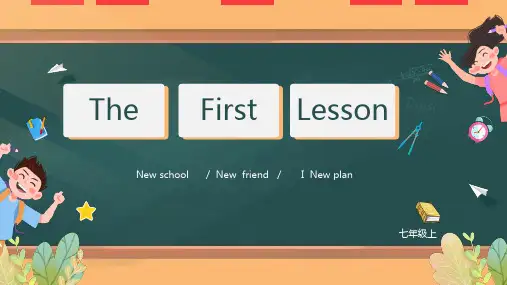
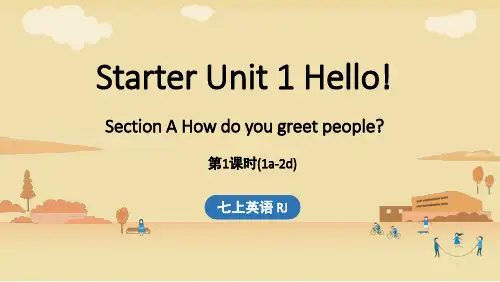
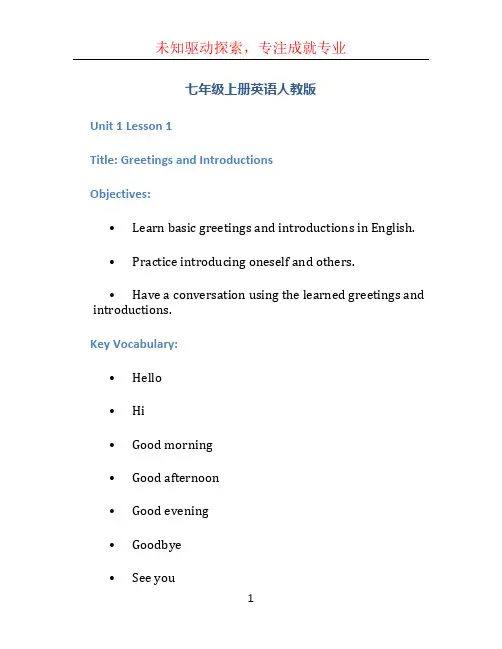
七年级上册英语人教版Unit 1 Lesson 1Title: Greetings and IntroductionsObjectives:•Learn basic greetings and introductions in English.•Practice introducing oneself and others.•Have a conversation using the learned greetings and introductions.Key Vocabulary:•Hello•Hi•Good morning•Good afternoon•Good evening•Goodbye•See you•How are you?•I’m fine, thank you.•What’s your name?•My name is…•Nice to meet you.Lesson Content:In this lesson, we will be learning how to greet people and introduce ourselves in English. Greetings are an important part of daily communication, and it’s essential to know how to address someone and initiate a conversation politely.We will start by learning different ways to say hello:1.Hello2.Hi3.Good morning4.Good afternoon5.Good eveningNext, we will learn how to bid farewell:1.Goodbye2.See youAfter greetings and farewells, we will focus on introductions. We will learn how to ask someone’s name and respond to sucha question:1.What’s your name?2.My name is…It’s also important to know how to ask so meone how they are doing and respond accordingly:1.How are you?2.I’m fine, thank you.By the end of the lesson, students should be able to use these greetings and introductions in conversations. They will be given opportunities to practice through various speaking activities, such as role-plays and group discussions.Assessment:To assess students’ understanding of the lesson, a short quiz will be conducted at the end of the class. The quiz will consist of questions related to greetings, farewells, introductions, and asking about someone’s well-being.Additionally, the students’ participation during the speaking activities will be observed and considered as part of their assessment.Further Practice:To further practice the skills learned in this lesson, students are encouraged to engage in conversations with their classmates using the greetings and introductions they have acquired. They can also practice with their family members or friends outside the classroom.Furthermore, students can use online resources or language learning apps to interact with native English speakers and practice their skills in real-life situations.Conclusion:In this lesson, we have learned how to greet people and introduce ourselves in English. Greetings and introductions are e ssential in daily communication, and it’s crucial to know how to initiate a conversation politely.By practicing and using the learned greetings and introductions, students will become more confident in their English speaking skills and feel more comfortable when interacting with English speakers.With continuous practice and exposure to the language, students will further improve their ability to engage in conversations and expand their English vocabulary.。
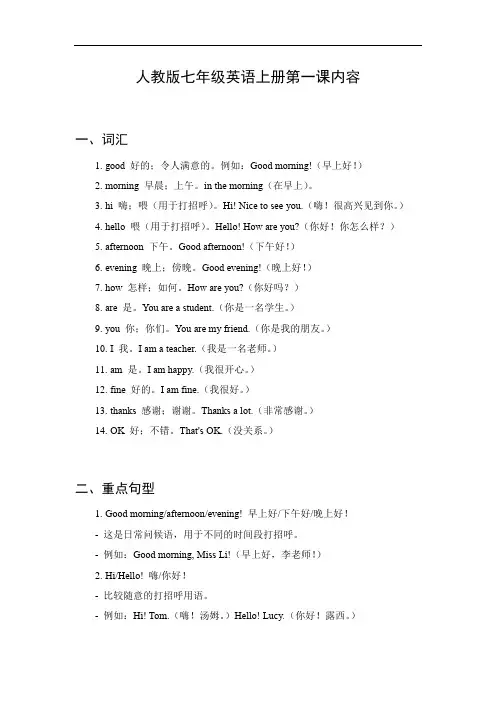
人教版七年级英语上册第一课内容一、词汇1.good 好的;令人满意的。
例如:Good morning!(早上好!)2.morning 早晨;上午。
in the morning(在早上)。
3.hi 嗨;喂(用于打招呼)。
Hi! Nice to see you.(嗨!很高兴见到你。
)4.hello 喂(用于打招呼)。
Hello! How are you?(你好!你怎么样?)5.afternoon 下午。
Good afternoon!(下午好!)6.evening 晚上;傍晚。
Good evening!(晚上好!)7.how 怎样;如何。
How are you?(你好吗?)8.are 是。
You are a student.(你是一名学生。
)9.you 你;你们。
You are my friend.(你是我的朋友。
)10.I 我。
I am a teacher.(我是一名老师。
)11.am 是。
I am happy.(我很开心。
)12.fine 好的。
I am fine.(我很好。
)13.thanks 感谢;谢谢。
Thanks a lot.(非常感谢。
)14.OK 好;不错。
That's OK.(没关系。
)二、重点句型1.Good morning/afternoon/evening! 早上好/下午好/晚上好!-这是日常问候语,用于不同的时间段打招呼。
-例如:Good morning, Miss Li!(早上好,李老师!)2.Hi/Hello! 嗨/你好!-比较随意的打招呼用语。
-例如:Hi! Tom.(嗨!汤姆。
)Hello! Lucy.(你好!露西。
)3.How are you? 你好吗?-用于询问对方的身体状况等情况。
-回答可以是:I'm fine, thanks.(我很好,谢谢。
)/Fine, thank you.(很好,谢谢你。
)/I'm OK.(我很好。
)等。
三、语法1. be 动词的用法- am 用于第一人称单数I 后面,例如:I am a student.(我是一名学生。
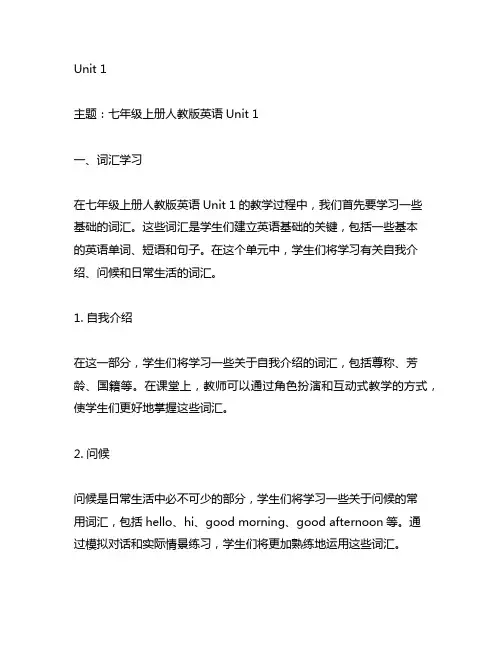
Unit 1主题:七年级上册人教版英语Unit 1一、词汇学习在七年级上册人教版英语Unit 1的教学过程中,我们首先要学习一些基础的词汇。
这些词汇是学生们建立英语基础的关键,包括一些基本的英语单词、短语和句子。
在这个单元中,学生们将学习有关自我介绍、问候和日常生活的词汇。
1. 自我介绍在这一部分,学生们将学习一些关于自我介绍的词汇,包括尊称、芳龄、国籍等。
在课堂上,教师可以通过角色扮演和互动式教学的方式,使学生们更好地掌握这些词汇。
2. 问候问候是日常生活中必不可少的部分,学生们将学习一些关于问候的常用词汇,包括hello、hi、good morning、good afternoon等。
通过模拟对话和实际情景练习,学生们将更加熟练地运用这些词汇。
3. 日常生活在这一部分,学生们将学习一些关于日常生活的词汇,包括家庭成员、饮食、爱好等。
这些词汇将帮助学生们更好地描述自己的生活,增强他们的交际能力。
二、语法学习除了词汇,语法也是英语学习的重要组成部分。
在Unit 1中,学生们将学习一些基础的语法知识,包括动词的时态、名词的单复数和形容词的比较级等。
1. 动词的时态学生们将学习一些基本的动词时态,包括一般现在时、一般过去时和一般将来时。
通过练习和应用,学生们将掌握这些时态的用法,从而更加准确地表达自己的想法。
2. 名词的单复数在Unit 1中,学生们将学习名词的单复数形式,包括一般名词、不规则名词和复合名词的变化规则。
掌握这些规则将帮助学生们更准确地理解和运用英语。
3. 形容词的比较级形容词的比较级也是Unit 1中重点学习的内容之一。
学生们将学习形容词及其比较级的构成规则,以及比较级的用法和常见的比较结构。
三、听力和口语训练在Unit 1的教学过程中,除了词汇和语法,听力和口语也是学生们需要重点训练的方面。
通过听力练习和口语表达,学生们将提高自己的听力和口语水平。
1. 听力练习通过一些简单的听力练习,学生们将提高自己的听力能力,更好地理解和掌握英语。

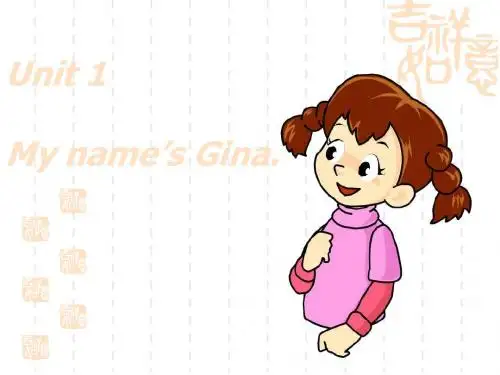
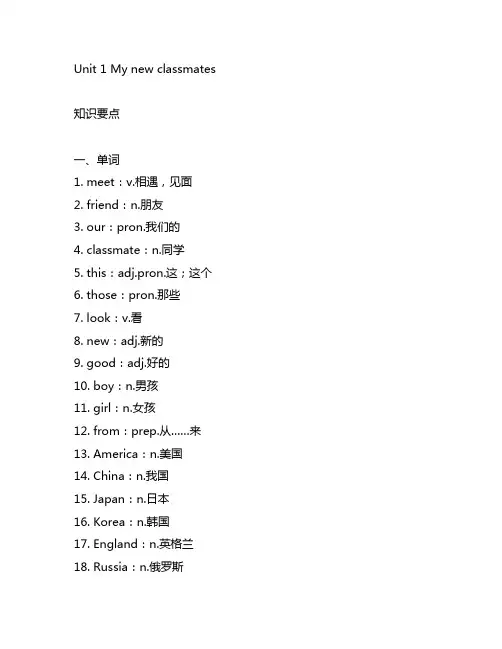
Unit 1 My new classmates 知识要点一、单词1. meet:v.相遇,见面2. friend:n.朋友3. our:pron.我们的4. classmate:n.同学5. this:adj.pron.这;这个6. those:pron.那些7. look:v.看8. new:adj.新的9. good:adj.好的10. boy:n.男孩11. girl:n.女孩12. from:prep.从……来13. America:n.美国14. China:n.我国15. Japan:n.日本16. Korea:n.韩国17. England:n.英格兰18. Russia:n.俄罗斯19. Th本人land:n.泰国20. France:n.法国21. Australia:n.澳大利亚二、重点句型1. Nice to meet you.:很高兴见到你。
2. Are they from China?:他们来自我国吗?3. Where is he from?:他来自哪儿?4. Look at the new student.:看看这位新同学。
三、语法1. 形容词的最高级形容词比较级+than+其他成分如:Tom is taller than Mike.特殊形容词:good-better-best,bad-worse-worst,much/many-more-most,little-less-least2. 人称代词的对象形式主格:I,you,he,she,it,we,they宾格:me,you,him,her,it,us,them如:This is my friend. I like him.3. 介词from的用法用来表示人或事物所从属的国家或地点如:He is from China. She is from Japan.四、交际用语1. 自我介绍Hello, I’m Mary. Nice to meet you.2. 询问他人来自何处Where are you from?3. 介绍他人身份This is my friend, John. He is from England.4. 与他人交谈Look at the new student. He is from Australia.以上就是人教版七年级上册英语unit1的知识要点,通过学习这些内容,相信同学们可以更好地掌握本单元的知识,轻松应对课堂教学和课后作业。
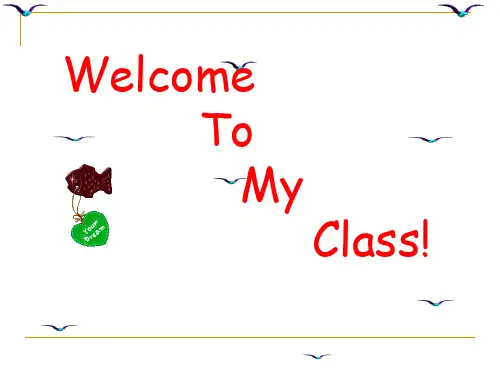
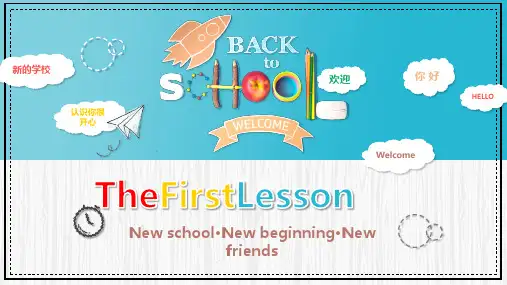
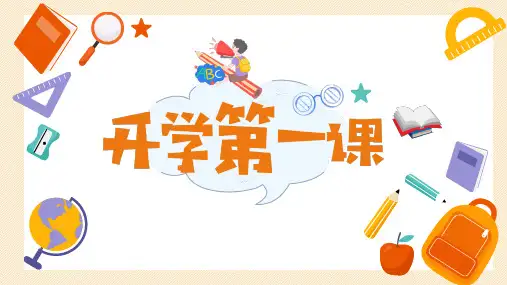
人教版七年级上册英语第一课讲解
以下是有关人教版七年级上册英语第一课的讲解:
首先,本课将学习问候和介绍他人的基本表达。
学生将了解如何使用英语进行简单的自我介绍和询问他人的基本信息,例如姓名、年龄和职业等。
本课的核心知识点包括:
1. 问候语:如“Hello”、“Hi”和“Good morning”等。
2. 介绍他人的句型:如“This is my friend, John”和“She is a doctor”等。
3. 询问和回答关于个人信息的句型:如“What’s your name?”、“How old are you?”和“What’s your job?”等。
本课的教学重点和难点包括:
1. 正确使用问候语和介绍他人的句型,避免混淆或遗漏重要信息。
2. 在询问和回答个人信息时,能够灵活运用不同的疑问词和代词。
通过本课的学习,学生将能够用英语进行基本的自我介绍和询问他人,提高他们的口语交际能力。
同时,他们将了解英语中常见的问候和介绍他人的表达方式,为后续的学习打下坚实的基础。
七年级上册英语人教版第一课一、重点单词和短语。
1. name(名字)- 这是个超级常用的单词啦。
比如说,“My name is Tom.”(我的名字是汤姆。
)我们每天都会用到这个词来介绍自己或者问别人的名字呢。
就像你刚认识一个新朋友,你肯定会说“Hello! What's your name?”(你好!你叫什么名字?)- 这个词可好用了。
当你想夸一个东西或者人不错的时候就可以用。
比如“Nice to meet you.”(很高兴见到你。
)这是我们初次见面时很礼貌、很友好的表达。
想象一下,你和新同学见面,脸上带着微笑说“Nice to meet you.”,是不是感觉很温馨呀?3. to(不定式符号,无实际意义;也可作介词表示“到,向”等)- 在“Nice to meet you.”这个句子里,“to”就是那种没有实际意义的小符号,但是又很重要哦。
如果没有它,这个句子就不对啦。
不过它作介词的时候就有实际意义了,像“go to school”(去上学),这里的“to”就是“到”的意思,表示去的方向是学校。
4. meet(遇见,相逢)- 这个词很有趣呢。
比如说你在公园里散步,突然看到了你的小伙伴,你就可以说“I meet my friend in the park.”(我在公园遇见我的朋友。
)它就像一个小魔法,把两个人或者事物联系在一起的那种感觉。
5. too(也;太)- 当它表示“也”的时候,就像个小跟班。
比如“Nice to meet you, too.”(我也很高兴见到你。
)它跟在别人说“Nice to meet you.”后面,就像在附和一样。
当它表示“太”的时候,就有点夸张的感觉了,像“This box is too heavy.”(这个盒子太重了。
)就像在强调这个盒子重得有点超出想象啦。
6. your(你的;你们的)- 这是个表示所属关系的词。
比如说“Your book is very interesting.”(你的书很有趣。
人教版七年级上册英语第一课单词1. good /ɡʊd/ adj. 好的-解析:表示令人满意的、良好的状态或品质。
例如:a good book(一本好书)。
2. morning /ˈmɔːnɪŋ/ n. 早晨;上午-解析:一天中的早期时段。
例如:Good morning!(早上好!)3. Good morning! 早上好!-解析:用于早晨见面时的问候语。
4. hi /haɪ/ interj. (用于打招呼)嗨;喂-解析:比较随意的打招呼用语。
例如:Hi! Nice to see you.(嗨!很高兴见到你。
)5. hello /həˈləʊ/ interj. 你好;喂-解析:较为正式的打招呼用语。
例如:Hello! How are you?(你好!你怎么样?)6. afternoon /ˌɑːftəˈnuːn/ n. 下午-解析:中午之后到傍晚之前的这段时间。
例如:Good afternoon!(下午好!)7. Good afternoon! 下午好!-解析:下午见面时的问候语。
8. evening /ˈiːvnɪŋ/ n. 晚上;傍晚-解析:太阳落山后的时间。
例如:Good evening!(晚上好!)9. Good evening! 晚上好!-解析:晚上见面时的问候语。
10. how /haʊ/ adv. 怎样;如何-解析:用于询问方式、情况等。
例如:How are you?(你怎么样?)11. are /ɑː(r), eə(r)/ v. 是-解析:be 动词的一种形式,与第二人称you 及复数主语连用。
例如:You are a student.(你是一名学生。
)12. you /juː/ pron. 你;你们-解析:第二人称代词,主格和宾格形式相同。
例如:How are you?(你怎么样?)13. How are you? 你好吗?-解析:常用的问候语,用于询问对方的身体状况或近况。
14. I /aɪ/ pron. 我-解析:第一人称代词主格形式。
七年级上册人教版英语第一课笔记以下是一篇关于七年级上册人教版英语第一课的笔记:课题:Hello!一、单词:hi/hello - 你好goodbye - 再见nice/pleased to meet you - 很高兴见到你how are you? - 你最近怎么样?fine/good - 好的,不错的thank you - 谢谢you're welcome - 不客气see you - 再见what's your name? - 你叫什么名字?my name is... - 我叫...spell it, please - 请拼写一下how old are you? - 你多大了?I'm...years old - 我...岁了open/close your book, please - 请打开/合上你的书read after me/follow me - 请跟我读look at my mouth/face - 请看我的口型/脸repeat after me/say it again - 请跟我重复一遍very good/well done - 非常好listen to me/pay attention to me - 请听我说/注意听我说follow the directions on the tape - 请按照磁带上的说明去做二、语法:1、问候和告别:使用“hi”或“hello”进行问候,用“goodbye”进行告别。
在某些情况下,也可以使用“pleased to meet you”来表达见到某人的高兴。
2、询问和回答:使用“how are you?”来询问对方的近况,回答时可以使用“fine”或“good”。
当别人向你表示感谢时,你可以使用“thank you”来回答。
当别人向你道歉时,你可以使用“you're welcome”来表示不客气。
3、介绍自己:使用“my name is...”来介绍自己,例如“my name is Li Lei”(我叫李雷)。